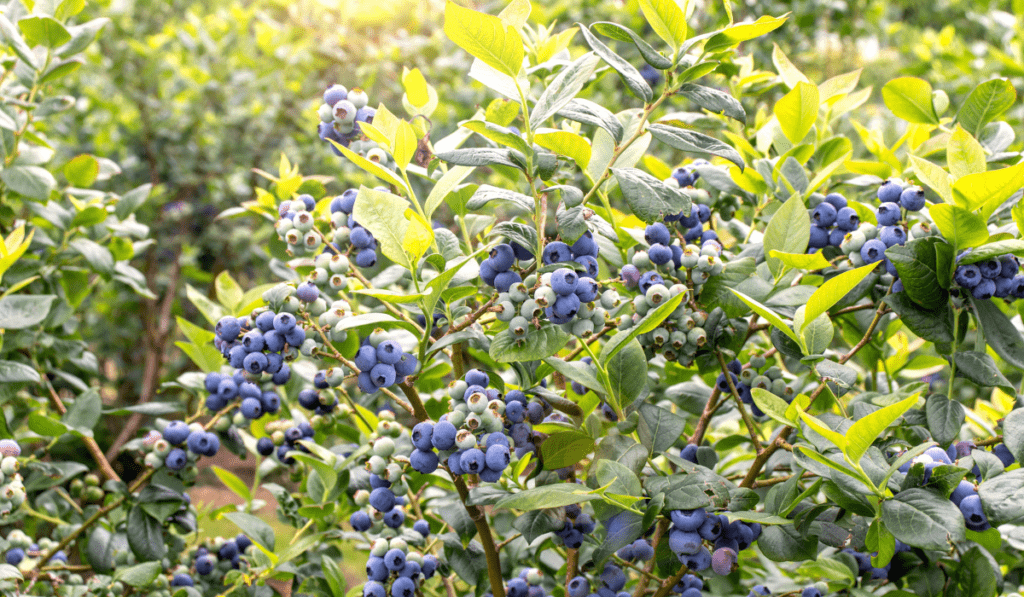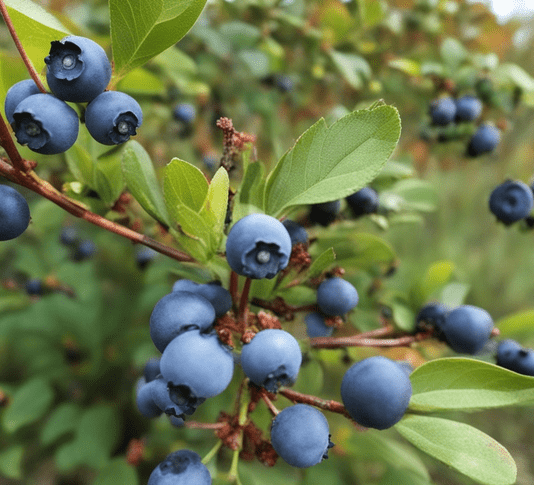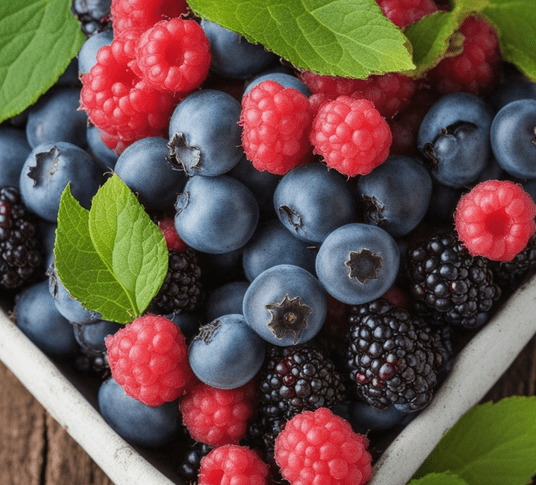Have you ever dreamed of plucking juicy, sun-kissed Southern Highbush Blueberries right from your backyard? The journey from planting to harvesting these delectable berries is both rewarding and fruitful. Are you ready to embark on a blueberry adventure? In this guide, we unravel the secrets of planting Southern Highbush Blueberries, offering you a comprehensive roadmap. Get ready to nurture thriving bushes and savor the sweetness of your homegrown harvest.
Choosing the Right Location for Planting Southern Highbush Blueberries:
Creating the perfect home for your Southern Highbush Blueberries begins with strategic choices. From sunlight exposure to soil drainage, we explore the critical factors that set the stage for a flourishing blueberry haven.
Sunlight Exposure:
Southern Highbush Blueberries crave sunlight. Discover the ideal locations that maximize sun exposure for optimal growth.
Air Circulation:
Explore the importance of air circulation and its impact on preventing diseases and fostering a healthy blueberry environment.
Soil Drainage:
Unearth the secrets of well-draining soil and its role in preventing waterlogged conditions that can harm your precious blueberry bushes.
Elevation and Frost Protection:
Delve into the significance of elevation and frost protection strategies to safeguard your Southern Highbush Blueberries from climatic challenges.
Structural Support:
Learn about providing structural support to ensure your blueberry bushes stand tall and strong, laden with succulent fruits.
Microclimates:
Navigate the nuances of microclimates, understanding how these small-scale climates can influence the success of your blueberry cultivation.
Preparing the Soil for Planting Southern Highbush Blueberries:
The groundwork for a thriving blueberry patch begins with soil preparation. From early groundwork to effective weed control, master the art of nurturing your soil for optimum blueberry growth.
Early Preparation:
Lay the foundation for success by initiating early soil preparation. Discover the benefits of proactive measures that pave the way for healthy blueberry bushes.
Incorporating Organic Matter:
Understand the role of organic matter in enriching the soil, promoting nutrient availability, and creating a favorable environment for Southern Highbush Blueberries.
Soil Test:
Dive into the importance of soil testing, unlocking valuable insights into your soil’s composition and allowing you to make informed decisions.
pH Adjustment:
Explore the critical role of pH in blueberry health and learn how to adjust soil acidity levels for optimal growing conditions.
Enhancing Drainage:
Elevate your understanding of soil drainage and its impact on preventing water-related issues that can compromise the well-being of your blueberry plants.
Weed Control:
Wage war against weeds and safeguard your blueberry patch from unwanted competition. Discover effective strategies for weed control that contribute to a thriving blueberry orchard.
Selecting and Purchasing Southern Highbush Blueberries Plants:
Embark on a journey of selecting the perfect Southern Highbush Blueberry plants. Follow these essential steps to ensure your choices align with your unique growing conditions.
Assess Your Growing Conditions:
Before you start your blueberry plant shopping spree, assess your specific growing conditions. Understand the impact of climate, soil type, and sunlight availability on the success of your Southern Highbush Blueberries.
Research Blueberry Varieties:
Dive into the diverse world of Southern Highbush Blueberry varieties. Conduct thorough research on cultivars, considering factors like fruit size, flavor profile, and disease resistance. Unearth the unique characteristics of popular varieties like ‘Sunshine Blue,’ ‘Sharpblue,’ and ‘Misty.’
Purchase from Reputable Nurseries:
Opt for nurseries or garden centers with a proven track record of providing healthy, disease-free plants. Ensure that your chosen establishment prioritizes the well-being of their blueberry bushes.
Check Plant Health and Vigor:
Prioritize the health and vigor of your prospective blueberry plants. Inspect foliage for signs of pests, diseases, or nutrient deficiencies. Choose plants with vibrant green leaves and sturdy stems, avoiding those with wilted or discolored foliage.
Consider Maturity and Size:
Tailor your choices to your preferences and garden space. Decide between mature plants that offer quicker yields and smaller, younger plants that allow you to witness the growth process. Factor in the expected size of fully grown bushes to ensure they harmonize with your garden layout.
Ask for Expert Advice:
Don’t hesitate to seek guidance from knowledgeable staff or local gardening experts. Tap into their insights on Southern Highbush Blueberry needs, inquire about the history of the plants, and gather valuable care tips for optimal growth.
Check for Pest and Disease Resistance:
Prioritize varieties known for their resistance to common blueberry pests and diseases. Opting for resistant plants minimizes the need for chemical interventions, simplifying the cultivation process.
Planting Southern Highbush Blueberries – Step-by-Step Guide:
Embark on the planting journey with a step-by-step guide, ensuring each Southern Highbush Blueberry finds its perfect spot in your garden.
Selecting Quality Plants:
Choose robust, disease-free plants with well-developed root systems. Ensure the plants exhibit signs of health, such as vibrant leaves and strong stems.
Timing is Everything:
Time your planting correctly, aligning it with the dormant season. Planting during this period allows the bushes to establish roots before the active growing season.
Digging the Perfect Hole:
Dig holes that are twice as wide and just as deep as the plant’s root ball. This provides ample space for root expansion and nutrient absorption.
Planting Depth Matters:
Plant your blueberries at the same depth as they were in the nursery containers. Ensuring the correct planting depth contributes to the overall health and stability of the bushes.
Mulch for Moisture Retention:
Apply a layer of organic mulch around each plant to retain moisture, suppress weeds, and regulate soil temperature. Mulching is a crucial step in promoting optimal growing conditions.
Watering:
Provide ample water immediately after planting and maintain consistent moisture levels. Adequate watering is vital for the establishment of your Southern Highbush Blueberries.
Support Structures:
Install support structures, such as stakes or cages, to aid young plants in establishing an upright growth habit. Supporting your blueberries from the early stages contributes to long-term stability.
Monitor and Adjust:
Regularly monitor soil moisture, adjust watering as needed, and stay vigilant for signs of pests or diseases. Proactive monitoring ensures timely interventions and promotes overall plant health.
Prune for Growth:
Initiate light pruning to encourage healthy growth. Remove any damaged or dead branches, allowing the plant to direct energy towards new, productive growth.
Caring for Southern Highbush Blueberries:
Unlock the secrets to nurturing thriving Southern Highbush Blueberries. This section delves into the essential aspects of care, ensuring your blueberry bushes flourish year after year.
Watering:
Maintain a consistent watering schedule, ensuring the soil remains consistently moist but not waterlogged. Adequate hydration is crucial, especially during dry spells or hot weather.
Fertilizing:
Apply a balanced, acidic fertilizer during the growing season. Follow recommended dosage and timing guidelines to provide the necessary nutrients for robust plant development.
Mulching:
Refresh the mulch layer around your blueberry bushes regularly. Mulching aids in moisture retention, suppresses weeds, and provides insulation against temperature fluctuations.
Pruning:
Regular pruning is essential for shaping the bushes, removing dead wood, and stimulating new growth. Prune during the dormant season, focusing on maintaining an open and well-ventilated canopy.
Training and Support:
Continue to monitor and support the growth of your Southern Highbush Blueberries. Adjust support structures as needed and guide the branches to maintain an optimal shape.
Pest and Disease Monitoring:
Stay vigilant for signs of pests and diseases. Regularly inspect the foliage, and take prompt action if any issues arise. Implement preventative measures, such as applying organic pesticides, to maintain plant health.
Harvesting Practices:
Enjoy the fruits of your labor by adopting proper harvesting practices. Harvest ripe berries gently, ensuring you leave unripe ones for later. Aim for a balance between regular harvesting and allowing some berries to fully ripen on the bush.
Winter Preparation:
Prepare your Southern Highbush Blueberries for the winter months. Mulch around the base of the plants to protect the roots from extreme temperatures. Prune lightly to remove dead or damaged wood, promoting a healthier bush come spring.
Pruning and Training Southern Highbush Blueberries
Delve into the art of pruning and training to sculpt your Southern Highbush Blueberries into productive and visually appealing plants.
Understand Pruning Goals:
Identify your pruning goals, whether it’s shaping the bush, promoting air circulation, or removing dead wood. Tailor your pruning approach based on these objectives.
Initiate Annual Pruning:
Conduct annual pruning during the dormant season. Remove any dead, damaged, or diseased branches. Thin out crowded areas to enhance air circulation and sunlight penetration.
Shape the Canopy:
Encourage a well-shaped canopy by selectively pruning branches. Aim for an open structure that allows sunlight to reach all parts of the bush, fostering uniform fruit ripening.
Remove Low Growth:
Eliminate low-growing branches that may touch the ground. This reduces the risk of disease transmission, enhances air circulation, and facilitates easier harvesting.
Prune for Size Control:
Manage the size of your blueberry bushes by pruning strategically. Remove a portion of older wood each year to stimulate the growth of new, productive branches.
Training Young Plants:
Guide the growth of young plants by selectively pruning to shape the framework. This early training establishes a strong foundation for future growth and fruit production.
Thin Out Excess Growth:
Thin out excess growth within the canopy to maintain an even distribution of branches. This ensures that each part of the bush receives adequate sunlight.
Pruning and Training Southern Highbush Blueberries
Follow our Step by Step guideline for pruning your southern highbush blueberries.
Address Crossing Branches:
Identify and address crossing branches that may rub against each other. Crossing branches can create points of entry for diseases and hinder the overall health of the bush.
Remove Weak or Unproductive Wood:
Identify and remove weak or unproductive wood. This redirects the plant’s energy toward healthier branches that are more likely to bear abundant fruit.
Adjust Support Structures:
If you’ve provided support structures for your blueberry bushes, adjust them as needed. Ensure that the support system adequately accommodates the size and structure of the bush.
Encourage Vertical Growth:
Encourage vertical growth by selectively pruning horizontal or drooping branches. This promotes a more upright growth habit, which can enhance air circulation and make harvesting more accessible.
Monitor for Diseases:
While pruning, keep an eye out for any signs of diseases or pests. Promptly remove affected branches to prevent the spread of issues throughout the plant.
Sterilize Pruning Tools:
Before and after pruning each plant, sterilize your pruning tools to minimize the risk of spreading diseases. A simple solution of bleach and water can be effective for this purpose.
Consider Plant Age:
Adjust your pruning approach based on the age of the plant. Young plants may require more shaping, while older plants benefit from maintenance pruning to renew and invigorate growth.
Common Pests and Diseases of Southern Highbush Blueberries
Safeguard your Southern Highbush Blueberries from potential threats by understanding and addressing common pests and diseases.
Blueberry Maggots:
Identify blueberry maggots by monitoring for small puncture wounds on berries. Use insecticides or traps to manage infestations, and promptly remove and destroy affected fruit.
Aphids:
Keep an eye out for aphids on the undersides of leaves. Hose off aphids with a strong stream of water, or introduce natural predators like ladybugs to control their population.
Mummy Berry Disease:
Prevent mummy berry disease by applying fungicides at the right time, typically during bud break. Remove and destroy any fallen berries, as they can harbor the fungal spores.
Botrytis Blight:
Manage botrytis blight by ensuring good air circulation, especially in humid conditions. Remove and dispose of any infected plant material, and consider applying fungicides preventatively.
Scale Insects:
Control scale insects by pruning and disposing of infested branches. Introduce natural predators, such as parasitic wasps, and use horticultural oils to manage scale populations.
Leaf Spot Diseases:
Address leaf spot diseases by applying fungicides and practicing good sanitation. Remove and destroy infected leaves, and avoid overhead watering to minimize moisture on foliage.
Spotted Wing Drosophila:
Monitor for spotted wing drosophila by using traps and harvesting fruit promptly. Consider applying insecticides, and clean up fallen fruit to reduce the risk of infestation.
Japanese Beetles:
Control Japanese beetles by handpicking or using insecticides. Consider planting beetle-resistant companion plants and removing beetles manually to minimize damage.
By staying vigilant and implementing preventive measures, you can protect your Southern Highbush Blueberries from these common pests and diseases, ensuring a healthy and productive crop.
How to Harvest Southern Highbush Blueberries
Embark on the final and rewarding stage of your blueberry journey by mastering the art of harvesting Southern Highbush Blueberries.
Monitor Ripeness:
Regularly monitor the ripeness of your blueberries. Look for berries that have turned fully blue, indicating maturity and sweetness.
Gentle Harvesting:
Harvest blueberries gently to avoid damaging the delicate fruit. Hold the stem with one hand and use the other to pick the berries, leaving the stem attached.
Harvesting Frequency:
Harvest frequently as the berries ripen. This ensures that you collect berries at their peak, promotes continuous production, and prevents overripening on the bush.
Use a Berry Comb:
Consider using a berry comb for efficient harvesting. Gently comb through the clusters to dislodge ripe berries, allowing them to fall into a collection container.
Morning Harvest:
Opt for morning harvests when temperatures are cooler. This minimizes stress on the berries and preserves their firmness.
Avoid Crushing Berries:
Handle harvested berries with care to avoid crushing them. Use shallow containers to prevent the weight of the berries from squashing those at the bottom.
Post-Harvest Handling:
Upon harvest, promptly refrigerate or process the berries. Refrigeration maintains freshness, while processing allows you to enjoy your harvest in various culinary delights.
Leave Unripe Berries:
Leave unripe berries on the bush for subsequent harvests. This staggered approach ensures a more extended harvest period.
Conclusion:
Congratulations on completing your comprehensive guide on how to plant, care for, and harvest Southern Highbush Blueberries! By mastering the fundamentals of choosing the right location, soil preparation, selection and purchase of plants, planting techniques, care routines, and dealing with potential challenges, you’ve equipped yourself with the knowledge to nurture thriving blueberry bushes.
Whether you’re a seasoned gardener or a novice, cultivating Southern Highbush Blueberries can be a rewarding experience. From the joy of watching your plants flourish to the satisfaction of harvesting sweet and nutritious berries, each stage of the process contributes to a fulfilling gardening journey.
Remember, success in blueberry cultivation requires a combination of careful planning, attentive care, and a love for the process. As you embark on this adventure, enjoy the beauty of your blueberry bushes, delight in the delicious harvests, and take pride in the knowledge and skills you’ve gained.
Happy gardening, and may your Southern Highbush Blueberries thrive and bring joy to your home for seasons to come!



